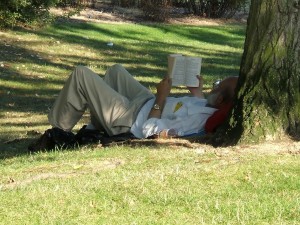“The difference between fiction and reality? Fiction has to make sense.” — Tom Clancy
We’ve looked at the importance of the first lines of chapter one, scene one. But how about all the other scenes?
Tweetable
- Your scene openings must not leave your readers feeling like they’ve just snapped out of a coma.
click to tweet
 The first lines of a scene must let the reader know the “who,” “where,” “when,” and “mood” of the scene so the reader is ready for new action and events.
The first lines of a scene must let the reader know the “who,” “where,” “when,” and “mood” of the scene so the reader is ready for new action and events.
Let’s look at two scene lead-ins that do well in grounding the reader, and see why that is.
EXCERPT 1: The Shadow of Your Smile by Susan May Warren (Chapter 3/Scene 1)
 She hurt everywhere – her arms, her legs – her entire body ached, right to her bones. And her head. As if a vise gripped it, pain screwed through her, eliciting a moan from places deep inside.
She hurt everywhere – her arms, her legs – her entire body ached, right to her bones. And her head. As if a vise gripped it, pain screwed through her, eliciting a moan from places deep inside.
“I’m right here, Noelle.
The voice brought her forward, from the webbed blackness, from the place where pain held her prisoner. …
Where’s the grounding? This opening shows me a female is just realizing her pain from an event. In the dialog, Warren quickly lets us know it’s Noelle. Then in the next sentence, we learn she’s been unconscious.
I like this because instead of Warren telling us right up front that Noelle realizes she’s been unconscious, she lets us experience the confusion with Noelle. In this case, the reader experiencing uncertainty about the “where” works.
But Warren soon removes the confusion. In the next paragraph, she uses smells and sights to let us know Noelle is in a hospital. Now we’re ready to roll.
EXCERPT 2: The Narrow Path by Gail Sattler (Chapter 4/Scene 2)
 “Ach, you should not be here in my kitchen getting your own tea. You are a guest.” Susan extended one arm in the direction of the doorway. “You should be showing your pictures and good ideas to the men. I will bring you more tea when it is ready. Go into the living room.”
“Ach, you should not be here in my kitchen getting your own tea. You are a guest.” Susan extended one arm in the direction of the doorway. “You should be showing your pictures and good ideas to the men. I will bring you more tea when it is ready. Go into the living room.”
“Thanks,” Miranda said. Nervously, she ran her hand down her slim skirt. …
Where’s the grounding? From the Ach, I immediately know the speaker is one of the Mennonite characters. Then I know we’re in the kitchen and the speaker is Susan. I know some tension exists. And from information in prior scenes, I’d know the other person’s identity by what Susan says the person should be doing and that she’s a guest. But in case I don’t know, Sattler tells me it’s Miranda in the very next paragraph.
I like this because Sattler used dialog effectively to ground me. And interesting dialog, at that. The foreign expression hints at the speaker’s “who.” Susan’s accusation gets the “where” established. Her advice shows the other person’s identity.
Tweetable
- Look for interesting techniques to ground readers at the start of a scene.
click to tweet
What advice and cautions do you have on grounding the reader in a scene?



 RSS - Posts
RSS - Posts



I think the biggest challenge is showing, not telling. Your examples are great for that.
I agree, Jane. These authors showed how it was, instead of just telling us.
Wonderful post, Zoe. Thanks, I’m tweeting & sending to Google Plus.
Thanks, Janet, for spreading my reach. I’m glad you got something out of the post.